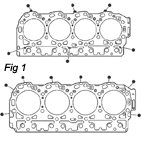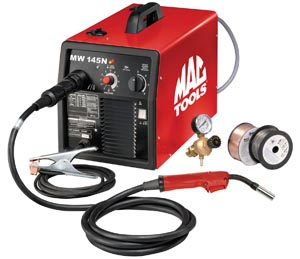Servicing Solutions: GM’s Durable Duramax Diesel
General Motors launched the Duramax Diesel 6.6L V8 engine in the Chevrolet Silverado and GMC Sierra 2500HD and 3500 Series trucks with Allison automatic transmissions in 2001. The application expanded to the Chevrolet Kodiak and GMC Topkick medium-duty trucks for 2003, with 16,000-, 18,000- and 19,500-lb. gross vehicle weight ratings (GVWR). According to its engineers,

Upgrading Rotors for Hard-Driving Fleets
Police cars, ambulances, taxis, parcel delivery trucks and even pizza delivery vehicles can chew up brake pads and rotors almost as fast as any race car. Hard use combined with frequent, sudden stops makes the brakes run hot, and when brake temperatures shoot up, the life of the pads and rotors plummets. For every increase
Mac Tools Introduces the New 145 Amp MIG Welder 115VAC
Mac Tools introduces the new 145 AMP MIG Welder 115VAC – MW145N. This compact welder is specifically designed for MIG welding stainless steel and makes welding fast, easy and spatter free. With a higher duty-cycle and the ability to manipulate the speed and heat, the user has greater control over the welding process. Features, such

Tech Tip: Chrysler Engine Mount Noise
I know the majority of you auto techs are extremely proficient at finding and repairing sources of strange and unusual noises. Although chasing these audible emissions can be time consuming and without a doubt aggravating, the customer’s concerns are usually valid and can often be of monumental importance to them.
Selling Services: Bleeding ABS Brakes after Component Replacement
Bleeding the brakes after brake components have been replaced is a step you don’t want to skip if you want a firm brake pedal. Air trapped in the lines, calipers or wheel cylinders will make the pedal feel soft and spongy. Air is compressible, so when the brakes are applied any air bubbles in the
Engineering: What Goes Up, Must Come Down!
Validating that the vehicle brake system is capable of getting the vehicle down a mountain is one of the major tests that occurs during the development and “prove-out” of the vehicle. In most cases, the manufacturer or the brake system supplier will test the vehicle on the road. This is also where a lot of
Doing the ‘Complete’ Brake Job
Brake work continues to be a solid service opportunity for independent repair shops because brakes are items that inevitably wear out. Disc brake pads need to be replaced, and the rotors usually need to be turned or replaced. The front brakes do the most of the braking, so they receive most of the attention when
Rotor Runout: Cause and Correction
The vehicle owner may say that under light braking the vehicle pulses to a stop or under heavy braking the vehicle shudders. Technical service bulletins (TSBs) often describe these symptoms as a “judder.” There are only two causes for judder — lateral runout and disc thickness variation on the rotor’s friction surface. What could have
Braking Horsepower: How Much Does Your Car Have?
We all know brakes get hot, sometimes very hot. If you watch closely on race day, it’s not uncommon to see the rotor on a race car glowing bright orange. Iron is in the range of 1,700º F when orange. At the most basic level, a brake is an energy conversion device. Normally people will
Drum Brake Self Adjusters: Understanding These Ancient Devices
d bridge bolts. Opposing piston calipers are bolted to the knuckle and have pins to position the pads. Drum brakes have return springs to return the shoes to a rest position and hardware to hold the shoes to the backing plate. The shoes return to a fully retracted or rest position when the master cylinder
Subaru Brake System Service
Over the last 25 years or so, Subaru has been the top- selling all-wheel-drive car here in the Pacific Northwest. For beachcombers and skiers alike, as well as rock hounds and hikers, having all-wheel drive is a big plus. Stop-and-go commuting, and difficult mountain driving take their toll on both drivers and vehicles. Of all
What Were They thinking?
hey pick the size of the parts? What prevented them from making them bigger? What kind of tests did the parts and the vehicle have to endure to be judged ready for the market? These are all questions that go into the design of the brake system for the vehicle. These decisions are the responsibility
